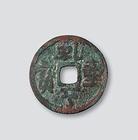Five Dynasties and Ten Kingdoms
General Introduction to Five Dynasties and Ten Kingdoms
 Five Dynasties and Ten Kingdoms was an era of political upheaval in China, between the fall of the Tang Dynasty and the founding of the Song Dynasty. During this period, five dynasties quickly succeeded one another in the north, and more than 12 independent states were established, mainly in the south. However, only ten are traditionally listed, hence the era's name, "Ten Kingdoms." Some historians, such as Bo Yang, count 11, including Yan and Qi, but not Northern Han, viewing it as simply a continuation of Later Han. This era also lead to the founding of the Liao Dynasty.
Five Dynasties and Ten Kingdoms was an era of political upheaval in China, between the fall of the Tang Dynasty and the founding of the Song Dynasty. During this period, five dynasties quickly succeeded one another in the north, and more than 12 independent states were established, mainly in the south. However, only ten are traditionally listed, hence the era's name, "Ten Kingdoms." Some historians, such as Bo Yang, count 11, including Yan and Qi, but not Northern Han, viewing it as simply a continuation of Later Han. This era also lead to the founding of the Liao Dynasty.
After Zhu Quanzhong usurped the Tang Dynasty (618-907) and founded the Latter Liang Dynasty (907 - 923), there were sequentially four dynasties after that. All these five dynasties were called Five Dynasties in Chinese history. Meanwhile, there were also ten kingdoms originating from the former Jiedushi (regional military attachment) of Tang. Hereunder is the timeline of the Five Dynasties and Ten States:
Background
Towards the end of the Tang Dynasty, the imperial government granted increased powers to the jiedushi, the regional military governors. The Huang Chao Rebellion weakened the imperial government's authority, and by the early 10th century the jiedushi, who commanded de facto independence, were not subject to the authority of the imperial government. Thus, the Five Dynasties and Ten Kingdoms ensued.
Five Dynasties in North China
The period of the five dynasties lasted for only 53 years, from 907 to 960. In 907, Zhu Quanzhong established the Latter Liang in Kaifeng (provincial capital of Henan Province).In his reign, old conventions of the Tang Dynasty were discarded while new reforms were reinforced. However, Zhu did not pursue the cause of unification and later became corrupt. In 923, Latter Liang was defeated by Li Cunxu. The Latter Tang lasted for 14 years. During this dynasty, the second emperor of Latter Liang, Emperor Mingzong, was an enlightened emperor. He carried out many favorable policies under which people lived an affluent life. Likewise, rulers of the Latter Tang did not unify the whole country either. Finally, the regime was destroyed by Emperor Mingzong's brother-in-law Shi Jingtang, with the help of the Qidan group from the northern areas. After the downfall of the Latter Tang, Shi Jingtang was enthroned as emperor of the Latter Jin by the king of the Qidan group. In this way, the regime of the Latter Jin was attached to the Qidan group. Till the reign of Shi Zhonggui, who was the foster son of Shi Jingtang, wanted to break away from the control of Qidan. Unfortunately, the Latter Jin was captured by Qidan who afterwards set up the Liao Dynasty in capital Kaifeng.
Ten Kingdoms in South China
Although the Qidan group established a new dynasty, their regime did not last long in the central plain areas because of the objection from the local people. Before long, Liu Zhiyuan, a man from Taiyuan, led his army into the central plain and soon founded a new dynasty - Latter Han. In 950, suspecting that a military general named Guo Wei plotting to rebel, Liu Chengyou (the second emperor of the Latter Han) wanted to kill him. But Liu Chengyou did not fulfill his goal; instead, Guo Wei along with his military force killed Liu Chengyou and founded Latter Zhou in 951. Comparatively, the Latter Zhou was the most prosperous one among the five dynasties. Under the wise ruling of Guo Wei and his foster son Chai Rong, the national strength was greatly enhanced. In that period, the rulers gradually unified almost the whole country. But the third emperor was a child who was enthroned at the age of seven. In 960 when the regime unstable, a military general in the court, named Zhao Kuangyin, took the chance of resisting the Liao aggressors and launched a mutiny in Chenqiao County. Soon the child emperor had to yield the throne to Zhao, after which a new dynasty - Song Dynasty (960 - 1279) was founded.
Popular culture
The 2006 Chinese film The Banquet by director Feng Xiaogang is set in this period. However, it has no historical accuracy, nor does it claim to have any. Comparatively, the Latter Zhou was the most prosperous one among the five dynasties. Under the wise ruling of Guo Wei and his foster son Chai Rong, the national strength was greatly enhanced. In that period, the rulers gradually unified almost the whole country. But the third emperor was a child who was enthroned at the age of seven. In 960 when the regime unstable, a military general in the court, named Zhao Kuangyin, took the chance of resisting the Liao aggressors and launched a mutiny in Chenqiao County. Soon the child emperor had to yield the throne to Zhao, after which a new dynasty - Song Dynasty (960 - 1279) was founded.



 闽公网安备 35020302000788号
闽公网安备 35020302000788号